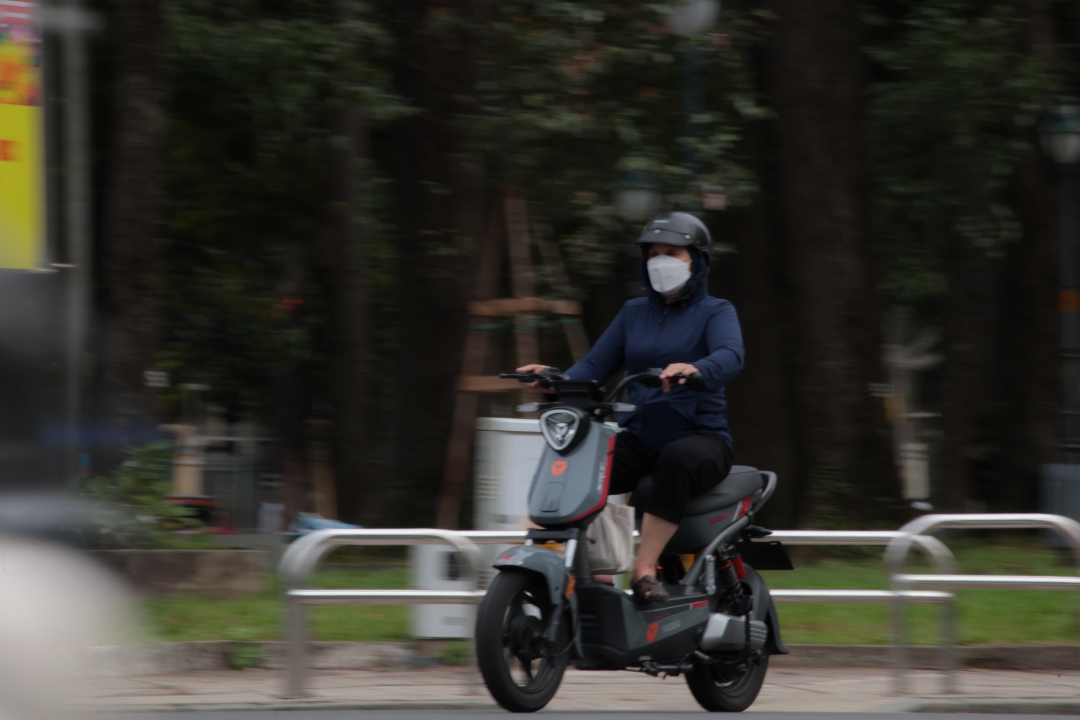The upcoming ban on gasoline-powered motorbikes within Hanoi’s Ring Road 1, combined with HCMC’s push to electrify ride-hailing services next year, is poised to ignite a race toward electric mobility
Electric motorbikes to boom?
Vietnam’s motorbike market has been treading water since 2018. Sales peaked at around 3.3 million units that year but dropped to just over 2.7 million by 2020. In the years that followed, the market settled into a plateau, stabilizing at approximately 2.5 million units annually.
Entering 2024, Vietnam’s motorbike market began to rebound, posting a 5.46% year-on-year increase and surpassing 2.6 million units sold. In the first half alone, members of the Vietnam Association of Motorcycle Manufacturers (VAMM)—including Honda, Yamaha, Piaggio, Suzuki, and SYM—collectively sold over 1.2 million units, up 6.4% compared to the same period last year. This revival signals a turning point for the industry and paves the way for electric motorbike models.
Despite signs of recovery, official figures from VAMM only tell part of the story. The data excludes electric motorbike brands like VinFast, Pega, Dat Bike, and Yadea, as well as large-displacement motorcycle makers such as Kawasaki, KTM, Ducati, and Harley-Davidson. VinFast alone sold nearly 71,000 units last year, making it Vietnam’s leading domestic electric brand. When factoring in these unreported segments, actual motorbike consumption is likely far higher—especially as Vietnamese consumers increasingly gravitate toward green and sustainable mobility solutions.
Although electric motorbikes currently make up less than 10% of Vietnam’s total motorbike sales, market analysts point to their consistent growth and a wave of supportive government policies as key drivers of future expansion. These forces are laying the groundwork for a thriving electric mobility sector—poised to reshape the country’s two-wheeler landscape in the years ahead.
In a decisive push for cleaner urban living, Prime Minister Pham Minh Chinh recently issued a directive targeting environmental pollution. In line with this effort, Hanoi has set an ambitious goal to eliminate fossil fuel-powered motorbikes and scooters from within Ring Road 1 by 2026. The first phase of this plan kicks off in July next year, when gasoline-powered two-wheelers will be banned from operating in the city center.
Beginning in early 2028, Hanoi will implement sweeping restrictions on personal transportation. Motorcycles and scooters will be banned from circulation, while fossil fuel-powered cars will face limitations within Ring Roads 1 and 2. By 2030, these regulations will extend to Ring Road 3.
Starting in early 2026, HCMC will require drivers for app-based platforms to use electric vehicles for all new registrations. The transition is expected to span two years, with targets of 30% conversion by the end of 2026, 80% by 2027, and full completion by 2028.
This policy not only places significant pressure on traditional vehicle manufacturers but also opens up opportunities for domestic and international companies to accelerate the development of vehicle models that align with the new regulations.
Industry experts believe Vietnam’s surging commitment to green transportation—anchored by its net-zero emissions target by 2050—will be a key driver of electric vehicle growth nationwide.
Motorbike brands join the game
Vietnamese consumers now have access to an increasingly diverse range of electric motorbike options, with prices starting at just over VND10 million and climbing into the tens of millions of Vietnamese dong. Among domestic players, VinFast has emerged as the clear frontrunner in the electric segment. As of May 2025, the brand has secured third place in the overall motorbike market—surpassed only by Japanese heavyweights Honda and Yamaha.
According to Motorcycles Data, VinFast’s electric motorbike sales skyrocketed by 488% year-on-year in the first five months of 2025, while Yadea posted a solid 36.8% gain over the same period. These impressive figures underscore the strong growth potential of Vietnam’s electric two-wheeler market.
VinFast and Yadea are spearheading Vietnam’s electric motorbike market with a diverse lineup that spans entry-level, mid-range, and premium models—intensifying head-to-head competition. Beyond these two frontrunners, Vietnamese consumers benefit from a wide selection of alternative brands, including domestic players like Pega, Dat Bike, Selex Motor, Detech, DK Bike, and Dibao, as well as offerings from various Chinese manufacturers.
Statistics from the Ministry of Industry and Trade show that demand for electric motorbikes in Vietnam has increased by an average of 30–35% annually in recent years. As major urban centers intensify efforts to electrify transportation, this growth trajectory is expected to accelerate even further. Once cautious about entering the Vietnamese electric vehicle market, Japanese and Taiwanese motorbike brands are now significantly ramping up their engagement.
Honda, which commands approximately 80% of Vietnam’s motorbike market, has recently introduced its CUV e: electric model, imported from Thailand. Complementing this launch, Honda has rolled out a rental program for the CUV e: in Hanoi, HCMC, and Danang—offering users a flexible entry point into electric mobility. Meanwhile, the ICON e:, Honda’s first fully electric motorbike manufactured in Vietnam and priced under VND30 million, is shaking up the market with its competitive appeal.
 Other brands such as Yamaha, Piaggio, and Suzuki have also stepped into Vietnam’s electric motorbike market. Yamaha unveiled the Neo’s in late 2022, but its elevated price point has constrained widespread adoption. Piaggio followed with the launch of the Piaggio One the same year, though its market footprint remains modest.
Other brands such as Yamaha, Piaggio, and Suzuki have also stepped into Vietnam’s electric motorbike market. Yamaha unveiled the Neo’s in late 2022, but its elevated price point has constrained widespread adoption. Piaggio followed with the launch of the Piaggio One the same year, though its market footprint remains modest.
Suzuki has officially registered the design patent for its electric motorbike—the Suzuki e-Address—in Vietnam, signaling an imminent launch. Meanwhile, SYM has introduced an electric motorbike category on its website, though no official product releases have been announced. Both brands clearly recognize the vast potential of Vietnam’s electric vehicle market and are actively pursuing expansion strategies.
Indonesia’s Wedison is actively surveying the Vietnamese market, introducing nearly 20 electric motorbike models that span a wide range of designs and price points. Meanwhile, Yadea is constructing its second factory in Bac Giang, designed with an annual capacity of two million units—quadrupling the output of its existing facility. These developments underscore the ambitious expansion strategies of international electric motorbike manufacturers as they scale up production to tap into Vietnam’s growing EV market.
Challenges ahead
However, for Vietnam’s electric motorbike market to achieve truly sustainable growth, promotional policies alone will not suffice—it also demands close collaboration between businesses and regulatory bodies. One of the most pressing challenges is the absence of widespread, standardized charging infrastructure, which continues to hinder daily convenience and broader consumer adoption.
Battery degradation after just 2–3 years remains a widespread concern among electric motorbike users in Vietnam. Industry reports indicate that replacement costs typically range from VND5-15 million, depending on the model and battery type. For budget-conscious consumers, this substantial expense has emerged as a key barrier to broader adoption.
To ensure sustainable growth in Vietnam’s electric motorbike market, manufacturers must prioritize continuous upgrades in battery technology, expansion of fast-charging infrastructure, and delivery of transparent, dependable after-sales service.
Honda has taken the lead by committing to the use of batteries stored in specialized warehouses and subjected to rigorous quality inspections. Notably, the company plans to buy back customers’ used vehicles after three years and replace them with new batteries—offering greater peace of mind and long-term value. With Honda setting this benchmark, other brands will be compelled to introduce equally robust or superior policies to remain competitive.
As part of their long-term strategy, businesses are prioritizing pricing solutions and financial policies to accelerate Vietnam’s transition to green vehicles. These efforts include improving product quality, expanding after-sales services, and partnering with local authorities to build a robust and sustainable electric vehicle ecosystem—contributing meaningfully to the country’s green revolution. To support this momentum, the Government must implement favorable policies on fees, taxes, and loan programs, while also fast-tracking the development of public charging infrastructure in residential areas, shopping centers, and government offices.









